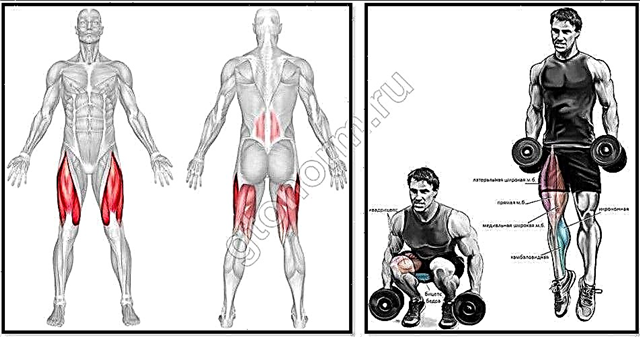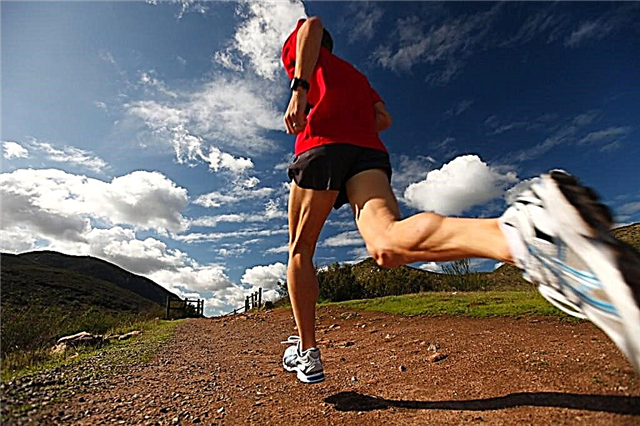Probably, many runners have met people running with small dumbbells on the track. As a form of running, dumbbell jogging is quite popular among sports enthusiasts.

Let's look at what is the difference between regular running and running with dumbbells, what are the positive and negative aspects of such a workout.
The difference between running with dumbbells and regular jogging
Taking dumbbells in your hands, you thereby additionally load your body: the cardiovascular system, joints, ligaments and tendons.
Your running takes on characteristic differences:
- the center of gravity of the trunk changes;
- muscles that were not previously included in the work are involved;
- the training load increases;
Center of gravity shift
Running with dumbbells leads to a shift and an increase in the center of gravity of the body and, as a consequence, a redistribution of muscle efforts, which compensates for such a redistribution of body weight.
Load for arm muscles
Additional weight in the hands exerts a training load on the trapezius and deltoid muscles, the biceps muscle of the shoulder (biceps), and thus the shoulder girdle and muscles of the upper limbs are well worked out.
Increase your workout intensity
The intensity of the load in running with an additional weighting agent is higher, respectively, the usual running distance will be more difficult to overcome. Consider this when planning your workout.
In order not to go beyond the established load and avoid fatigue, use the Karvonen formula:
Heart rate during exercise = (maximum heart rate - heart rate at rest) x intensity (in percent) + heart rate at rest. For example: age - 32, desired exercise intensity - 70%, resting heart rate 60.
- 220 - 32 = 188 (maximum heart rate);
- 188 - 60 = 128 (heart rate at rest);
- 128 x 70% = 89.6;
- 89.6 + 60 = 149.6 bpm.
Thus, the heart rate at a load intensity of 70% will be about 150 beats per minute. This formula can be used to monitor your training load. Start with 50% of the intensity of the load and gradually increase it, without going into the zone of maximum heart rate.
For the example above, the maximum heart rate zone is 170 - 188 beats per minute.
- 220 - 32 = 188 (maximum heart rate);
- 188 - 10% = 170 bpm.
Running with dumbbells: benefits and harms
Who is this type of running for?
Dumbbell running is available for different groups of people involved in sports from amateurs who are already in good physical shape to professionals.
This type of running will bring the greatest benefit:
- practicing martial arts (increases impact speed and endurance, strengthens the grip);
- playing sports (hockey, basketball, handball, volleyball);
- practicing technical sports (long and high jumping, throwing);
- those who want to increase the body's endurance and speed qualities at short running distances;
- those who want to lose weight (with the same time spent, more fat is burned);
- those who want to overcome the dynamic stereotype, destroy the old skill that hinders further progress;
- those who just want to diversify their running workouts;
Who is not suitable
- for beginners who have just started jogging (too much load on the musculoskeletal system, joints, especially knee joints, and violation of running technique during the period when it is just being formed);
- engaged in power sports and combining them with jogging (running load with dumbbells will reduce the effectiveness of strength training);
- have medical contraindications or problems with the spine, joints or cardiovascular system;
Dumbbell Running Tips
Before starting your running workout, check your Body Mass Index (BMI) to see if the shock load will be too much for you when using the extra weight.
BMI is a value that gives an idea of the correspondence between a person's mass and his height. The convenience of this index is that it allocates a certain range for the optimal weight without indicating a specific weight, as in the case of other calculations.
To determine your BMI, divide your weight by your height (in meters) squared, and divide your weight by that value.
For instance:
- height 162 cm, weight 60 kg;
- square of growth: 1.62 * 1.62 = 2.6;
- divide the weight by the value obtained: 60 / 2.6 = 23;
Thus, the body mass index is 23.
If the Index value: 19-25 (normal), 26-30 (overweight), from 31 (obesity).
If the body weight is overweight, it is better to limit yourself to regular jogging without additional weights, so as not to harm the knee joints.
Before jogging with dumbbells, do a full warm-up, warm up your joints, ligaments, muscles well. Perform several rotations in the shoulder girdle, hip, knee, and ankle. Do some squats, lunges, short accelerations. Stretch at the end of your run.
When running with dumbbells, try to avoid tarmac. This is the most unfriendly surface to our feet. The asphalt surface is hard and does not create a shock-absorbing effect, and the additional burden only intensifies the blows that are perceived by the knee joints and the entire musculoskeletal system.
The advantage of a ground surface is not only that it is softer than asphalt and thus softens the shock load, but also that it additionally loads your muscles due to its softness.
Rubber is the best running surface. If your stadium has rubber-coated treadmills, and you have the ability to go on such a track, then your running conditions are close to ideal!
Stick to the correct running technique: start at a slow pace, run from toe to heel, do not fully extend your knees, raise them while running, place your feet in the direction of movement. Watch the position of the torso while running, do not twist it.
Also note the following features of dumbbell running:
- if you are a beginner in running, go for a run without dumbbells, the additional load at the initial stage of training will only hurt you and negatively affect your joints and running technique;
- start with walking with dumbbells for 10 - 20 minutes to understand how ready you are for such a load;
- start running with dumbbells weighing 0.5 - 1 kg, gradually increasing their weight;
- use special, fitness dumbbells that do not slip out of your hands during running swings, and absorb moisture from your palms;
- you can also use patch cuffs with removable metal plates, which are fixed to the limbs with fasteners or Velcro;
- if it's hard to run the entire distance, alternate it with running without dumbbells;
- while running, hold the dumbbells at chest level, working with your hands, as in normal running, and not just holding the dumbbells in your hands;
- breathe deeper, through your nose, exhale forcefully every three steps, thereby you can concentrate more on running;
- avoid running over rough terrain, which is fraught with unpleasant injuries;
- Use running shoes with good cushioning: a thick sole, well-cushioned heel and foot;
Running with dumbbells is a fairly serious physical activity on the body, the positive effect of which you can get by observing moderation in increasing the intensity of the load, stretching well before jogging and listening to your physical condition.









